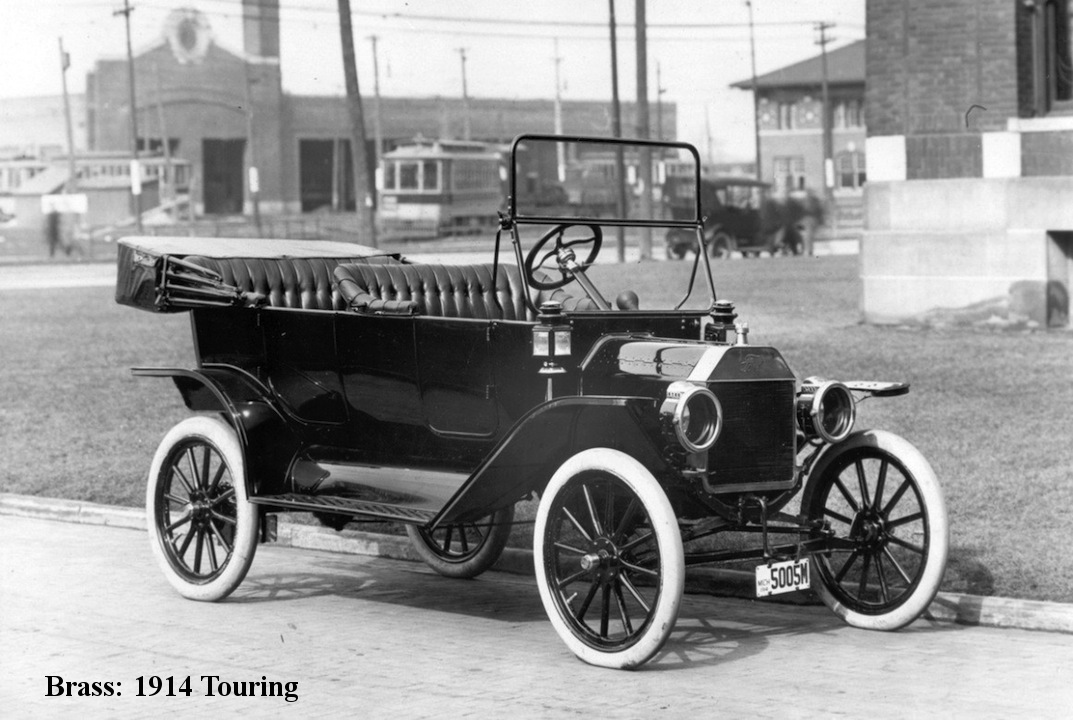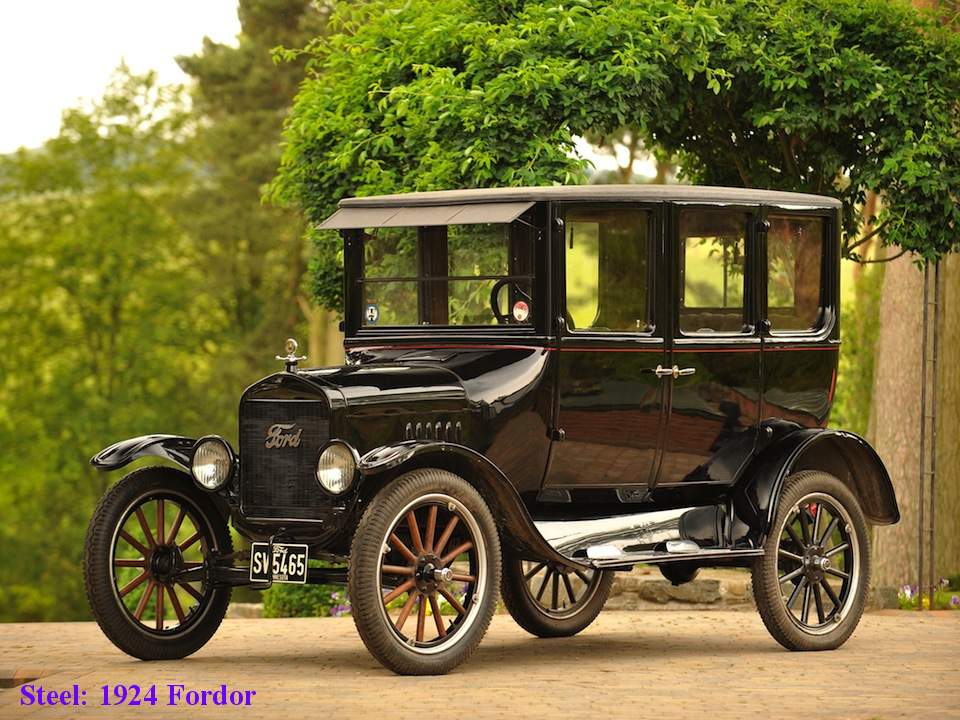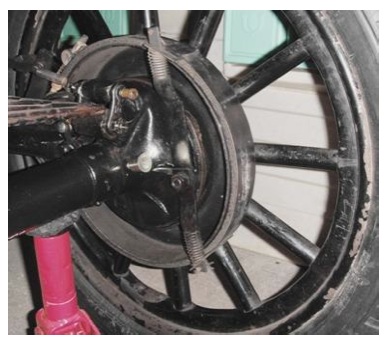|
Model T Fords come in three basic flavors; the "brass
cars" built between 1908 and 1916; the "steel cars"
built between 1917 and 1925 which were painted overall
black including the radiators; and the "improved cars"
built in 1926 and 1927, which, though available once
again in some nice colors, were still powered by the
same basic Brass Era 4- banger and 2-speed planetary
transmission, and were still stopped by the same type of
seriously outdated, single-drum, drive-train brake.
 Most
if not all of the brass Fords made between 1908 and 1911
had wooden bodies. A changeover was made to sheet
metal-covered wooden frames midway through the 1912
model year. Most
if not all of the brass Fords made between 1908 and 1911
had wooden bodies. A changeover was made to sheet
metal-covered wooden frames midway through the 1912
model year.
Brass cars command a much higher price than the steel or
improved cars. The earlier vintage brass cars are worth
much more than the later brass cars and even between
back-to-back model years, like 1912 and 1913, the 1912
car will command a significantly higher price than the
1913 car. It's no surprise, then, that the 1915 and 1916
model- year cars are the least expensive of the brass
cars (fetching somewhere in the neighborhood of $17,000
for a very good daily driver with good paint, upholstery
and top, in good mechanical condition).
This pricing principle does not hold true for the "steel
cars," all of which are worth about the same price,
assuming identical body style (touring, roadster, etc.)
and equal condition. As far as daily-drivers are
concerned, a fair steel car might run $5,000; a good
one, $10,000 and a creampuff might fetch $13,000 (oh,
and by the way, I'm not talking about show cars that win
trophies at sanctioned Antique Automobile Club of
America competitions. Prices for those rolling works of
art—whether brass or steel—are astronomical and you
wouldn't dare drive one in traffic).
The "improved cars" enjoy upgrades like balloon tires,
geared-down steering and slightly better brakes. In
terms of price, they're worth about the same as the
black cars, but look so similar to the Model A Ford that
you almost might as well get one of those and enjoy its
greater cruising speed and highway capability.
As originally manufactured, the earlier Model T's were
lighter and had slightly more power. They do perform
better than the later cars, but that isn't really saying
very much. The Model T is not a highway car. Its best
cruising speed is about 35 mph — 40, if you don't mind
abusing the engine. That means most of your afternoon
drives will pretty much be limited to a forty or
fifty-mile radius. Taking a Model T beyond that distance
involves either getting out of bed earlier or towing the
car on a trailer. That having been said, in the summer
of 2009, fifty-four Model T Fords drove from New York to
Seattle. Traveling in caravan is much easier, safer and
more fun than going it alone.
For reasons of simplicity (and perhaps a reluctance on
the part of Mr. Ford to pay royalties to those who held
patents on more conventional accessories), theModel T
had some basic equipment unique unto itself. This
included a flywheel-mounted, low-voltage magneto; 4-coil
ignition and a 2-speed planetary transmission featuring
a brake that transmitted the braking impulse down the
drive-shaft, through the differential, to that rear
wheel which had the least traction. The most important
thing to understand about driving Model T is that it was
designed to have the same braking capability as the
Titanic. It will take time and patience to learn to
drive a Model T. In fact, it's best to have someone
teach you.
 People
think of the Model T as being tough to the point of
being indestructible. That's a myth. In some ways, it is
far more delicate than any modern car—yet many thousand
examples of this century-old design are on the road
today. The car's obstinate longevity is mostly due to
its having been produced in ridiculously large numbers,
its go-kart simplicity and a super-availability of parts
(not to mention the best technical advice forum on the
internet). Aside from powerplant overhauls, you can
pretty much do all of your own maintenance. The car
always needs tinkering and a little at a time, you'll
learn what you need to know about twirling screwdrivers
and bending cotterpins. People
think of the Model T as being tough to the point of
being indestructible. That's a myth. In some ways, it is
far more delicate than any modern car—yet many thousand
examples of this century-old design are on the road
today. The car's obstinate longevity is mostly due to
its having been produced in ridiculously large numbers,
its go-kart simplicity and a super-availability of parts
(not to mention the best technical advice forum on the
internet). Aside from powerplant overhauls, you can
pretty much do all of your own maintenance. The car
always needs tinkering and a little at a time, you'll
learn what you need to know about twirling screwdrivers
and bending cotterpins.
Here are some questions to consider while making a pre-
purchase inspection:
What is the general condition of the car and is
everything on it in working condition? A generally dirty
car with dust on the seats hasn't been run in a while
and that tells you something about recent maintenance.
That doesn't mean a car that looks good is good—because
the race is not always to the swift, nor the battle
always to the strong, but if you're going to bet, that's
the way to go.
Has the car suffered any damage or been in a serious
accident? A century-old car is going to be carrying some
baggage, so it's not reasonable to expect a vestal
virgin, but as a first-time buyer, you definitely want
to avoid a car that has structural issues like a bent
frame.
Is the front end nice and tight? It's easy enough to
rough- test for tightness in the front end by rocking
the steering wheel side to side and checking for
excessive play. If you're mechanically inclined, taking
the play out of a loose front end is fairly
straightforward, but for a newbie, it's a headache you
don't need right off the bat.
Is there any rust on the car? Model T Fords are made of
some seriously good quality materials, but corrosion on
a car is never a good thing. Perforation rust on the
body is more serious than fender rust because it may be
indicating the presence of wood rot beneath. Most Model
T's have wooden frames covered by sheet metal.
So, is there any wood-rot in the body? Fixing this
problem can be expensive and difficult. Significant wood
rot is a problem for an experienced restorer, not a
first-time antique car hobbyist.
Is there a lot of Bondo in the body? This isn't
critically important, but it can become a point when
negotiating price.
In what condition is the paint job? Same as above.
In what condition is the upholstery? Ditto. Is this car
a Ford-factory-built original, or was it custom- built
later on from parts? This is a value-related question.
An original is simply worth more.
 Does
the engine start well when hand-cranked? Some of these
cars have self-starters and that includes retro-fitment
of some of the early brass cars which came out of the
factory with no electrical system whatsoever. A starter
is a wonderful thing to have because when you stall the
car in heavy traffic, setting the brake and getting out
front to begin a lengthy wrestling match with a stubborn
engine while frustrated, angry drivers are trying to
pass at close quarters, can be a humbling experience. At
the very least, you want a non-self-starting car to
start easily when hand- cranked. Does
the engine start well when hand-cranked? Some of these
cars have self-starters and that includes retro-fitment
of some of the early brass cars which came out of the
factory with no electrical system whatsoever. A starter
is a wonderful thing to have because when you stall the
car in heavy traffic, setting the brake and getting out
front to begin a lengthy wrestling match with a stubborn
engine while frustrated, angry drivers are trying to
pass at close quarters, can be a humbling experience. At
the very least, you want a non-self-starting car to
start easily when hand- cranked.
Does the engine run smoothly, have good power, etc.? A
correctly running, stock Model T engine is a joy to
drive. A properly set-up magneto is important because
getting in there to adjust the thing is just not a
practical option for someone new to the hobby. On the
other hand, the four individual coils, which also
benefit greatly from proper adjustment, are very
accessible and if you don't have the expertise to adjust
them yourself, it's a simple matter to ship them out to
an expert like "The Coil Doctor," who will have them
singing like The Shirelles.
Does the engine have a high-compression head? A high
compression head is the most effective piece of bolt-on
performance equipment you can buy. Don't expect a big
increase in cruising speed, but acceleration and
hill-climbing ability will be measurably improved. Other
enhancements might include a later-model carburetor,
like the NH, and/or a bigger intake manifold. These are
all easy to get.
Does the car have a generator? If not, then by what
method is the battery charged and where is the battery
mounted? None of the brass-radiator Fords were
manufactured with any kind of electrical system. In
fact, when electric headlights replaced acetylene
headlamps in 1915, these were wired up to the engine's
magneto. The headlights would be nice and bright at 30
mph, but dimmed down to almost nothing when the car
slowed for turns. Legend has it that you could burn out
the bulbs by exceeding 40 mph with the headlights
switched on. Henry Ford seemed to pride himself on being
the first to be last and he didn't begin installing
electrical systems in his cars until 1919, when 6-volt
batteries and generators appeared for the first time on
the Model T. The brass cars can be retro-fitted with
electrical systems, but of course, that would be a
significant departure from originality.
Is the radiator of the round-tube or flat-tube type? The
original round-tube radiator won't cool as efficiently
as the aftermarket, flat-tube radiators being
manufactured today. The issue is originality vs.
function.
Is the front wishbone attached to the top or to the
bottom of the front axle? Originally, the front wishbone
was attached to the top of the front axle. For reasons
of safety related to loss of steering control, that
geometry was changed in 1919 by instead attaching the
wishbone to the bottom of the axle. Some of the earlier
cars have been retrofitted.
Are the thrust washers in the differential made of
babbitt or bronze? The original babbitt thrust washers
in the differential have not aged well and so developed
a tendency to fall apart. When that happens, the firm
mesh of gears between the drive shaft and the
differential can loosen to the point where the
drive-train brake is rendered inoperative and the only
remaining means of stopping the car would be the parking
brake (unless you happen to have some kind of auxiliary
brakes installed on the rear wheels).
Does the car have a Ruckstell rear end? This 2-speed,
shiftable differential was one of the few aftermarket
items of which Henry Ford approved, and some of Ford's
dealers offered this as an option. It's a nice thing to
have if you live in a very hilly area or if you're going
to be driving in parades. The most serious disadvantage
of a Ruckstell is that it can get stuck in neutral
between gears and that renders the drive- train brake
completely ineffective.
 Does
the car have Rocky Mountain brakes? If you have a
Ruckstell rear end, you need Rocky Mountain Brakes (or
some other kind of auxiliary brakes). Rocky Mountain
Brakes became available as an aftermarket item in 1917.
They improve the Model T Ford's braking ability
dramatically, from abominable to bad. Rocky Mountain
brakes are of the "self-energizing" type, which means
they don't stop very well when the car is rolling
backwards. They're also reputed to work badly in wet
conditions (and this is why the original drive-train
brake, which functions in either direction and in wet
conditions, should be retained even when the car is
retrofitted with Rocky Mountain brakes). Does
the car have Rocky Mountain brakes? If you have a
Ruckstell rear end, you need Rocky Mountain Brakes (or
some other kind of auxiliary brakes). Rocky Mountain
Brakes became available as an aftermarket item in 1917.
They improve the Model T Ford's braking ability
dramatically, from abominable to bad. Rocky Mountain
brakes are of the "self-energizing" type, which means
they don't stop very well when the car is rolling
backwards. They're also reputed to work badly in wet
conditions (and this is why the original drive-train
brake, which functions in either direction and in wet
conditions, should be retained even when the car is
retrofitted with Rocky Mountain brakes).
Some folks have mounted disc brakes to the Model T and
that modification is commercially available. Though
these are extremely high quality units, that doesn’t
change the fact that the car has awfully skinny wheels
and when your tires have the same footprint as a
shot-glass, the best disc brakes in the world won't stop
the car in any shorter distance than the Rocky Mountain
type.
Does the car have de-mountable wheels? De-mountable rims
became available in 1919 and they make for much simpler
and quicker flat tire changes on the road, assuming
you're carrying spares. They're not correct on earlier
cars, but that hasn't stopped a lot of people from
retrofitting brass cars that frequently go on tour.
Does the car have an electric brake tail light and
directional signals? In an open car with the top down,
you may get away with hand signals, but an enclosed car
that is driven in traffic really needs turn signals
because hand signals won't be visible to someone on the
right side of the car. Either way, at least one
brake-light is a must, for obvious reasons.
Does the car have safety glass? Think of the old type of
glass windshield as a guillotine. Replacing such panes
with safety glass is a must.
When was the last time the car was driven? How often is
the car driven? Has it participated in any tours? Active
cars tend to be healthier cars. To take an inactive car
out of mothballs invariably costs significant bucks.
Buy the best car you can afford. It's almost always
cheaper to find and buy the one that's already restored
and equipped as you like than it is to buy a basket case
and restore it yourself.
|

